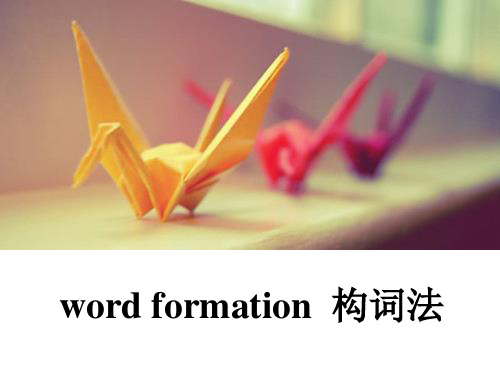book5u 4grammar
- 格式:doc
- 大小:85.50 KB
- 文档页数:2






译林版必修第一册Unit4单元语法--关系副词引导的限制性定语从句语法精析当先行词在定语从句中作状语时,通常要用关系副词引导定语从句。
常用的关系副词有where,when,why等。
1.关系副词wherewhere引导的定语从句的先行词往往是表示地点的名词(如place,room,house,spot等),关系副词在从句中作地点状语。
常用in which,at which,on which等代替。
They are playing in the park where(=in which) there are some flowers.他们正在有花的公园里玩耍。
The office where(=at which) the girl works is not far from here.这个女孩工作的办公室离这儿不远。
[温馨提示]①有一些先行词,如point,stage,position,case,condition等,属于抽象的地点名词,如果定语从句中缺状语,需要接where引导的定语从句。
You reach a point in your project where you just want to get the thing f inished.从事任何项目你都会进入一种境界:一心想完成它。
We reached a stage where we had to answer violence with violence.我们陷入了必须用暴力来对抗暴力的境地。
②where引导定语从句和状语从句的区别:引导定语从句时,where是关系副词,在从句中作地点状语,其前有表示地点的名词作先行词,从句修饰先行词;引导状语从句时,where是从属连词,从句修饰主句的谓语动词,where前面没有表示地点的名词。
He’s got into a situation where he is likely to lose control over the plane.(定语从句)他陷入了一种很可能会失去对飞机的控制的境地。
昌乐一中2011级高二英语学案 编制:石明臻 赵慧 赵振荣 李修斌 惠丽梅 彭海磊 审核: 石明臻 审批:刘明强 编号:5-4-5 班级: __ 姓名: __ 小组: 评价: _ 2012-96Unit 5 GrammarThe Inversion (倒装)Learning aims:1. To master the grammar rules about the Inversion2. To learn to analyze and solve grammar problems by self-study and cooperation.3. To set up your confidence of conquering grammar and experience the pleasure.【课前预习】一、请思考一个“严肃”的问题:你吃过的香香的“肉夹馍”为什么不叫“馍夹肉”呢?把“肉”置前,主(馍)谓(夹)完全颠倒过来,是为了______肉多。
这是汉语中的_______语法现象? 二、观察下列三个句子,回答问题。
1. Out of the building came a pretty woman.2. Never did she know the truth.3. Only when there is peace can people lead a happy life.哪个句子是完全倒装——主语和谓语完全颠倒过来?_______哪个句子是部分倒装—只将谓语部分的助动词或者情态动词提到主语前面? 三、欣赏下列短文,找出倒装句并用横线划出来,并判断是那种倒装? 1. When I arrived, I saw there was a tall tree at the entrance to the village. In front of the tree sat a lady in red. I didn’t know who she was at first , partly because I was near-sighted. Only when I came near could I recognize that she was my mother. My brothers haven’t returned home in the past ten years. Neither have I. We are all too busy with our work. Sometimes, I said to myself, “ Were I free, I w ould often visit my mother.” Of course I know this is only an excuse. Not until my father died did I make up my mind to return home and stay with my mother for some time. We three brothers gave our mom a call and promised to have a winter holiday with her. Once made a promise, we should keep it.2. “Stop thief! Stop thief!” There is a magic cry in the sound. The tradesman leaves his counter, … Away they run, pell -mell (乱七八糟), helter-skelter (仓促狼狈), yelling-screaming, …“Stop thief! Stop thief!” The cry is taki ng by a hundred voices, … Away they fly, splashing through the mud, up go the window, out run the people. ——From Charles Dickens’ Oliver Twist四、找出Reading text 中四个倒装句,并分析其属于那种倒装句。
1__________________________________________________________________2__________________________________________________________________3__________________________________________________________________4__________________________________________________________________ 倒装句的语用功能有1强调2.承上启下3.平衡句子结构 4.渲染气氛使行文生动【课内探究】倒装句分为两种:部分倒装(Partial Inversion )和完全倒装(Complete Inversion )I . 部分倒装 部分倒装是指将谓语的一部分如系动词、助动词或情态动词放在主语之前。
如果句中的谓语是实义动词,则需添加助动词do, does 或did ,并将其置于主语之前。
具体用法如下:1. 否定副词位于句首时的倒装 如:never, seldom, rarely, little, hardly, scarcely, no sooner, no longer, nowhere 等 (1) Seldom does he go out for dinner.(2)Hardly does she have time to listen to music.(3) No sooner had we reached the airport than the plane took off. 2.当not until…位于句首时,其后的主句要用倒装语序: Not until the rain stopped did he leave the room.3. 某些起副词作用的介词短语,由于含有否定词,若位于句首,其后要用部分倒装:by no means, at no time, in no way, in(under) no circumstances, in no case, on no account, in no sense, in no condition, eg: (1)On no accounts must this switch be touched.(2)In (Under) no circumstances will I lend money to him.4.“only+状语(或状语从句)”位于句首时,其后用部分倒装语序: (1)Only then did he realize that he was wrong. (2)Only in this way are you able to do it well.(3)Only when he returned home did he realize what had happened. 5. “so +adj. / adv.”位于句首时,其后用部分倒装:So sudden was the attack that we had no time to escape.6.“so+助动词/系动词/情态动词+主语”倒装 要表示前面提出的某一肯定的情况也同样适合于后者,通常用“So+助动词+主语”这种倒装结构:You are young and so am I./ /If he can do it ,so can I.若前面提出某一否定的情况,要表示后者也属于同样的否定情况,则应将其中的so 改为neither 或nor : You aren’t young and neither am I.7. 由not only…but also 引出的倒装 当not only…but also 位于句首引出句子时,not only 后的句子通常用部分倒装:Not only did he speak more correctly, but he spoke more easily8. 虚拟条件句倒装 当if 引导的虚拟条件从句中含有had, were, should 等时,如将if 省略,则要将had, were, should 等移到主语前,构成倒装句:Should you require anything give me a ring. II .完全倒装完全倒装是将句子中的谓语动词全部置于主语之前。
此结构通常只用于一般现在时和一般过去时。
完全倒装主要有四种类型 1. 表示地点的here 和 there 位于句首时,其后用完全倒装形式。
这类倒装句的谓语通常是动词be 和come, go 等表示移动或动态的不及物动词:Here comes the bus. 公共汽车来了。
There goes the last train. 最后一班火车开走了。
【注意】(1) 以上倒装句中的谓语动词come和go不能用进行时态,即不能说Here is coming the bus。
(2) 若主语为代词,则不用倒装:Here I am. Here it comes.(3) 其中的动词有时也可能是stand, lie, live等表示状态的动词(表示存在):There stood a desk against the wall. 靠墙放着一张书桌。
Once upon a time there lived a man known by the name of Beef.2. 地点副词away, down, in, off, out, over, round, up 等位于句首时,其后用完全倒装语序。
这类倒装句的谓语通常表示动态的不及物动词:Away went the runners. 赛跑选手们跑远了。
Round and round flew the plane. 飞机盘旋着。
【注意】若主语为人称代词,则不能用倒装:Away he went. Down it came. 3. 状语或表语位于句首时的倒装为了保持句子平衡或使上下文衔接紧密,有时可将状语或表语置于句首,句中主语和谓语完全倒装:Among these people was his friend Jim.By the window sat a young man with a magazine in his hand.【注意】在表语置于句首的这类倒装结构中,要注意其中的谓语应与其后的主语保持一致。